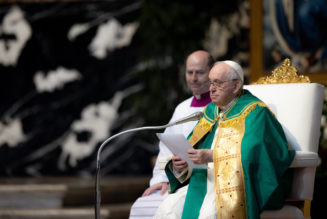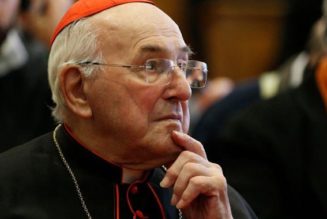
When I was asked to write about synodality for The Thomist, an academic journal, I tried to say no. I had not been avidly following developments, but I had noticed a lot of ersatz sociology, generally of poor quality, as well as a marked absence of the name of Jesus Christ.
The editor prevailed, however, and, for my sins, I decided to take a fresh look at the topic. I took my starting point from the etymology of synod, as a way (hodos) that comes together (syn). As I explored the language of “way” in the Scriptures, I discovered some important guideposts for an understanding of synodality that rises to a truly Christian (as opposed to merely sociological) level. In this essay, I will summarize those guideposts.
The most obvious referent for the word “way” is Christ Himself, who is “the Way and the Truth and the Life” (Jn 14:6). But the term “way” is first found in the Hebrew Scriptures, which speak of God’s way of righteousness, given to Israel in His law. “For the Lord watches over the way of the righteous, but the way of the wicked will perish” (Ps 1:6). “The way of the righteous is level; O Just One, you make smooth the path of the righteous” (Is 26:7). This language is developed in the New Testament. “For John came to you in the way of righteousness…” (Mt 21:32). “They have left the straight road and have gone astray, following the road of Balaam son of Bosor, who loved the wages of doing wrong…” (2 Pt 2:15). The “straight road” or “way of righteousness” is intimately connected with following God’s law. “Enter through the narrow gate; for the gate is wide and the way (hodos) is easy that leads to destruction, and there are many who take it. For the gate is narrow and the way (hodos) is hard that leads to life, and there are few who find it” (Mt 7:13–14).
Christ takes up these exhortations to righteousness and connects them to His Person; now the way of righteousness is not a matter only of following God’s law but following the Way Himself, in person. Even the Pharisees allowed that Jesus was “sincere, and [taught] the way of God in accordance with truth” (Mt 22:16), but He was something even more: the Way Himself.
The radicality of this statement can be even better understood by looking at the context of John 14, where Jesus names Himself the Way.
Jesus said, “Let not your hearts be troubled; believe in God, believe also in me. In my Father’s house are many rooms; if it were not so, would I have told you that I go to prepare a place for you? And when I go and prepare a place for you, I will come again and will take you to myself, that where I am you may be also. And you know the way [hodon] where I am going.” (Jn 14:1–4)
Up to this point, we (knowing the end of the story) might think that Jesus was talking about the way of His Cross, Resurrection, and Ascension. But Thomas, with his charism for saying out loud what everyone else is thinking, moves the conversation forward in a surprising way.
Thomas said to him, “Lord, we do not know where you are going; how can we know the way [hodon]?” Jesus said to him, “I am the way [Egō eimi hē hodos], and the truth, and the life; no one comes to the Father, but by me. If you had known me, you would have known my Father also; henceforth you know him and have seen him” (Jn 14:5–7).
Jesus’s response tells us that verses 4 and 6 interpret each other. The way-where-Jesus-is-going is the same thing as Himself. He is the way-where-he-is-going, as He goes to the Father, in person. Jesus is not merely the way for us, in the sense of an example to follow (although He is also that). He is Himself the way. He’s a noun but also, in some sense, a verb, the going itself.
This statement is simply incomprehensible—as the Apostles seemed to find it—without understanding some Trinitarian theology (so buckle up). According to St. Thomas Aquinas, the Persons of the Trinity are “subsisting relations.” To understand this, you need to know the distinction made by Aristotle between substance and accidents. As Thomas interpreted Aristotle, substances exist of themselves, as “a being” or “this thing.” In other words, this fruitfly, that human being, this maple tree. Fine, but what doesn’t “exist of itself” as “this thing”? Well, for one, “accidents.”
For philosophers, “accidents” do not mean dropping your mug of coffee or crashing your car. An accident is something that depends upon a substance to exist. Color, for example: this maple tree turns yellow in the fall. But yellow is not a thing that you point to, or that you take a day-trip to go visit. (“What are you doing this weekend?” “Oh, I’m driving up to see yellow.” “Uh, a yellow what?”) You don’t gaze upon yellow; you gaze upon yellow things. Color, like yellow, only exists in things—that is, in substances. So, color does not “exist of itself” but only “in things”—in substances, whose particular way of existing of themselves is also called subsisting. Substances subsist, while accidents exist in another.
Relations are accidents; you don’t bump into fatherhood but rather you bump into persons (substances!) who are fathers (relations). The exception proves the rule, that exception being… the Trinitarian Persons. In God, there are relations that act like substances, because these relations subsist. In other words, God the Father is not some (very, very, very) big guy who is also a father. Fatherhood in God is not an accident. In fact, nothing in God is an accident; He is completely simple. As Thomas puts it, “whatever is in God is God.” What in us is an accident—relation—in God is simply Himself. God doesn’t have love (as we do); He is love itself, identical with it (see I Jn 4:8).
Thus, God the Father is fathering itself, eternally generating the Son and breathing forth the Spirit. These aren’t discrete acts but simply identical with God the Father Himself. In that sense, the “verb”-aspect and the “noun”-aspect of the Triune Persons—Their doing and Their being—are simply identical.
So too the Son simply is the relation of filiation, of being generated by the Father, and is the breathing forth the Spirit. But then there’s something else about the Son: He becomes incarnate as Jesus Christ by assuming a human nature to His Person. As the God-man, Jesus tells Thomas that He is the-way-where-he-is-going. He can be that precisely because from all eternity He is the eternal reception of sonship from the Father. As the John 14 passage continues, “Very truly, I tell you, the one who believes in me will also do the works that I do and, in fact, will do greater works than these, because I am going to the Father” (Jn 14:12, emphasis mine).
Joseph Ratzinger calls this Jesus’s “exodus-being”; I have called it Christ’s vector-nature. Jesus’s whole existence is to be the way toward the Father and the Spirit. As the One sent by the Father into the world and who is going back to the Father (Jn 14:28), He is both the One sent and the Way itself of the sending-and-going.
We seem to be very far from “synodality.” And, indeed, that may be part of the problem. The hodos that Jesus isseems to be too far from people’s minds when they write and speak about synodality. Yet, to be fully Christian, we have to recognize that any “way” of synodality must be rooted in Christ the Way, in whom we Christians are to “live and move and have our being” (Acts 17:28, emphasis mine).
As Christians, we are called to be conformed, in a distant way, to the Son’s own coming-and-going from and to the Father: “As the Father has sent me, so I send you” (Jn 20:21); and conformed to His spirating of the Spirit: “[Jesus said,] ‘As the scripture has said, “Out of the believer’s heart shall flow rivers of living water.”’ Now he said this about the Spirit, which believers in him were to receive…” (Jn 7:38–39). As Ratzinger notes, “[B]eing a Christian means being like the Son, becoming a son; that is, not standing on one’s own and in oneself, but living completely open in the ‘from’ and ‘toward.’”
For this reason, perhaps, the Church of the Apostles came quickly to be called “the way” (Acts 9:2, et al.). The Church exists to be the way to the Way who is Christ. Here all the Old Testament language about the “way of righteousness” finds its ecclesial place, because the Jews knew that not all ways conform to God’s way. “Thus says the Lord: See, I am setting before you the way of life and the way of death” (Jer 21:8; see Dt 30:15). In the Letter to the Romans, Paul quotes Is 59:8: “Their feet are swift to shed blood; ruin and misery are in their paths, and the way of peace they have not known” (Rm 3:15–17). The context within Romans 3 is to emphasize that all have fallen short and require the redemption won by Christ’s blood. Only in Christ can we find the way of peace, because in Christ alone is salvation (see Acts 4:12).
To follow Him requires a certain way of life. “For God did not call us to impurity but in holiness. Therefore whoever rejects this rejects not human authority but God, who also gives his Holy Spirit to you” (I Thess 4:7–8). The body of the Christian is part of the body of Christ and the Temple of the Holy Spirit (see I Cor 6:17–19). “For you were bought for a price; therefore glorify God with your body” (I Cor 6:20). As Israel knew, so the Church repeats that there is a way of righteousness and a way of death.
Paul experienced this personally, having trod both ways. Shortly after receiving letters to persecute the Church, those “of the Way” (tēs Hodou, Acts 9:2), he himself is, as Ananias points out, the recipient of the Lord’s appearance to him “on the way” (en tē hodō, 9:17) to Damascus. What was intended to be a journey to the death of the Church becomes a journey to life for Paul and for the nations, within the bosom of the ecclesial way as represented by Ananias his healer and baptizer and by Barnabas his advocate (see 9:27). Paul writes and acts as he does in part to safeguard the steps of the nascent Church, so that she might walk firmly in the way that leads to the Way.
Thus, any version of synodality that neglects both Christ as the Way and the moral life as the way to Him does not rise to the level of syn-hodos, the way together.
But what of listening, diversity, and accompaniment, the oft-repeated slogans? How do they fit in? In fact, John 14 helps us to make sense of them as well. Verse 2 speaks of the many mansions in the Father’s house. Traditionally, this aspect of the Church has been expressed by one “mark” of the Church, namely, “catholicity” or “universality.” The Catholic Church is not a geographical or national or class-based institution; it is for everyone, of all times and places. Christianity is for “all the nations” (Mt 28:19), and Christ remains with us for “all the days” (Mt 28:20).
As Hans Urs von Balthasar puts it, each Christian, through his baptism, receives a “task and mission that belong to him and to no one else.” In fact, Balthasar argues, this mission is the secret to each human being’s identity. It contains “that most intimate idea of his own self—which otherwise would remain undiscoverable.”
These missions may include the creation of novel spiritualities and institutions, as the history of the Church abundantly testifies. Ratzinger says that these new forms “are the Holy Spirit’s answer to the changing circumstances in which the Church is living.” These new forms bubble up from below rather than being administratively imposed from above. “They have to be given to us, and they are given. We simply have to pay attention to them: by the gift of discernment…” Discernment, in other words, concerns the authenticity of a mission as measured by revelation and holiness. Is this new movement or spirituality a way to the Way? Or does it lead away from the Way?
Discernment is not a matter, in other words, of asking whether a particular path or opinion seems to be fulfilling to me. It is rather a matter of asking whether it conforms me more to Christ in the Spirit, and Paul warns us that conformity to Christ is cruciformity. We are to complete the sufferings of Christ (see Col 1:24) in our own flesh (see Gal 6:17), as a down-payment for the resurrection of that flesh in imitation of Christ (see I Cor 15:20).
Paul further tells us that missions are meant to build up the body of Christ, the Church. “Now there are varieties of gifts, but the same Spirit; and there are varieties of services, but the same Lord; and there are varieties of activities, but it is the same God who activates all of them in everyone. To each is given the manifestation of the Spirit for the common good” (I Cor 12:4–7, emphasis added; see also I Cor 14:4, 12). These charisms must be tested by the Church. “Test everything; hold fast to what is good; abstain from every form of evil” (I Thes 5:21–22).
One criterion the Church has regarding new movements is whether they conform to the “unity of the faith and of the knowledge of the Son of God” (Eph 4:13). Only through that unity will the unity of the body of Christ be maintained, so that it can “grow up in every way into him who is the head, into Christ, from whom the whole body, joined and knit together by every ligament with which it is equipped, as each part is working properly, promotes the body’s growth in building itself up in love” (Eph 4:15–16).
Heresy damages the unity of the body of Christ, therefore, but heresy simultaneously harms the true diversity of ecclesial missions. Paradoxically, therefore, without unity, the body of Christ would lack diversity as well! A body with all its parts must be unified to live. Otherwise, Balthasar insists, “there would be no living body but only sheer disparity,” individual parts of the body—this hand, that organ—cut off from the whole, lifeless, and ultimately rotting away. Office in the Church, such as the Magisterium, exists to serve this unity, and sometimes that means that the Church must say no to a Christian who insists on the authenticity of his or her discernment. Balthasar writes,
It is Church office that wrests the individual’s own criteria from him and hands them over to the Lord of the Church, guaranteeing that the Church’s experience of love shall transcend itself in the direction of the love of Christ (as Head of the Church) and shall overcome all its subjectivisms and attain the objectivity of that love that “believes all things, hopes all things, endures all things” (I Cor 13:7).
Thus, office within the Church must be attentive to the true diversity of missions within the body, as surprises of the Holy Spirit who blows where He will, and it must stretch all Christians out of their limited horizons to a truly universal, ecclesial plane.
Lumen Gentium from the Second Vatican Council tells us that the ecclesial task of fostering unity belongs fundamentally to the pope. In addition, each bishop is the principle and foundation of the unity of his diocese. These institutional roles are also charisms, that is, gifts of the Spirit, given to us by God for building up the body. They are not human impositions upon the freedom of the Church’s members, although they can appear or even be performed in that way; there is no guarantee that members of the hierarchy, even the Pope, will not err in their activity of confirming or suppressing ecclesial movements and charisms. This possibility is an inevitable result of the human aspect of the Church. But we cannot respond to this possibility by rejecting the whole structure. Rather, we have to trust that the Father’s providence will ensure that genuine missions will be completed, hopefully by the Christian who received the mission, but perhaps in another way, by another person, maybe in another age. The mission is more important than the individual achievements of the person given it. “I have planted, Apollos watered; but God gave the growth. So then neither the one who plants nor the one who waters is anything, but only God who gives the growth. The one who plants and the one who waters have a common purpose, and each will receive wages according to the labor of each” (I Cor 3:6–8).
These points sketch out, I believe, a truly Christian vision of synodality, rather than a substandard sociological one. The Way is Christ, who is the way-where-he-is-going, namely from and to the Father. The Church is the way to this Way, and she must call us to the way of righteousness so that we can “move” within the Way that is Christ. Synodality as a reflection upon the multiplicity of missions within the unity of the Church—her catholicity—can remind us of the process of true discernment of mission, which entails the cruciform building-up of Christ’s body, the Church.
Will the Synod on Synodality reflect these truths? Well, I’m no fortune-teller, and there are certainly discouraging signs. But if we are truly listening, Christians can hear Christ’s response: Egō eimi hē hodos, “I am the Way.” The Holy Spirit will give us the means, if we accept them, to find our being and to “move” within that Way.
Angela Franks, Ph.D., is a theologian, speaker, writer, and mother of six. She serves as Professor of Theology at St. John’s Seminary in Boston and as a Senior Fellow at the Abigail Adams Institute in Cambridge. She is a Life and Dignity Writing Fellow for Church Life Journal (University of Notre Dame).








